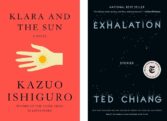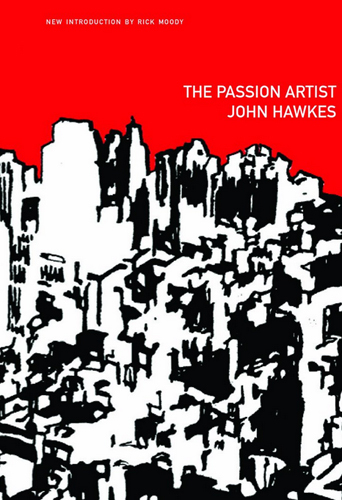
by by Margaret Kolb

Published by Dalkey Archive Press, 2010 | 185 pages
“You suffer this like a dream,” Flannery O’Connor wrote of John Hawkes’s novel The Lime Twig, and the same, certainly, might be said of his 1979 novel The Passion Artist, long out of print and, finally, re-issued in paperback by Dalkey Archive. Hawkes’s star has, unjustly, waned since his death in 1998; he has become something of a coterie author to devotees of the post-war American experimental novel. But, unlike such late near-contemporaries as, say, John Cheever, John Updike, or Bernard Malamud, Hawkes seems to have little currency in today’s broader literary culture. Even as the reputations of fellow avant-gardists like Donald Barthelme or William Gaddis remain strong, Hawkes’s work is threatened by eclipse.
Hawkes’s books may suffer from neglect these days, but his influence as a teacher—he taught creative writing at Brown for many years—endures. His teaching is, in fact, an important part of the story of American fiction in the latter half of the twentieth century. His former students include Jeffery Eugenides (who wrote a charming preface to New Directions’ recent re-release of Hawke’s masterpiece, Second Skin), Mary Caponegro, Percivel Everett, Jim Shepard, David Shields, Joanna Scott, Marilynne Robinson, and Rick Moody, who contributes a helpful introduction to this new edition of The Passion Artist. His reputation as a teacher is legendary, and his presence still looms, through his students, over American literature, even if in somewhat shadowed form. Marilynne Robinson recalls the “formidable Mr. Hawkes” defending her developing style against the criticisms of her classmates: “Momentously for me, he once put a blessing on a paragraph of mine. He called it Proustian.”
Vost’s routine—beer at La Violaine, flowers at Claire’s grave—is interrupted when, compounding his complex family romance, he discovers that his daughter has become a prostitute. He allows, in a kind of stupor, one of his daughter’s colleagues to take him home; a masterful set-piece of abject pornographic intensity relates Vost’s shamefaced submission to an apparently traumatic blowjob. “It was as if her head had become suddenly the head of a young lioness nuzzling at the wound it had made in the side of a tawny and still-warm fallen animal.” Afterwards, he reports his daughter to the police.
Well, one woe doth tread upon another’s heels here, and less than twenty-four hours later Vost discovers that the women of La Violaine have revolted. Vost joins a group of male volunteers helping to assist the police in suppressing the rebellion, but becomes a casualty of the revolt. In the hospital, he suffers some dreams of his own, full of ghost trains, his wife’s casket, himself as a hooded prisoner, and an accusatory female witness who charges him with not understanding women. After leaving the hospital, Vost quits his job at the pharmacy and retreats to the city’s fetid marsh, where his encounters with the escaped prisoners, including, eventually, his mother, led him steadily to his fate.
No summary can do justice to the surreal intensity, both erotic and comic, with which Hawkes draws Vost’s adventures. Hawkes always eschewed conventional realism; his novels are instead patterned according to their own complex logic of impulse and ritual. Their settings are often imaginary or, at best, only obliquely related to real times and places—a counter-factual post-war Germany in The Cannibal, a gothic American Southwest in The Beetle Leg, or here, a nameless, decaying European city. (Rick Moody, in his introduction, assumes the city is in Eastern Europe, though nothing in the text confirms this.) In The Passion Artist, graveyard, prison, and the nameless city containing them are drawn together in a series of explicit equivalencies: the cemetery is said to be “like a replica of the city itself,” while “the degradation concealed within La Violaine was no different from that implicit in the city in which the prison thrived.”
Hawkes’s greatness rests, finally, in his style: a kind of controlled over-writing appropriate to the gothic fabulism of his content. The style emerges brilliantly in the novel’s strong opening paragraph:
Unlike most people, Konrad Vost had a personality that was clearly defined: above all he was precise in what he did and correct in what he said. But Konrad Vost was only a middle-aged man without distinction or power of any kind, so that to others these two most obtrusive qualities of his personality were all the more odious. And since Vost also possessed self-insight and understanding of the feelings of friends and family, such as they were, he too found odious the main qualities that were himself. But the joy of being always precise and always right was insurmountable, so that he detested himself fiercely yet could hardly change. At times he thought that he was like some military personage striding with feigned complacency down a broad avenue awash with urine.
The Passion Artist might be thought of as a psychosexual fable, a hallucinatory allegory about misogyny and sexual trauma, with Konrad Vost as both cruel victimizer and hapless victim. Much of the book’s most disturbing, and also funniest (the two are often intertwined in Hawkes) material consists of flashbacks to Vost’s troubled childhood. After his father was killed and his mother imprisoned, the young Konrad Vost finds himself in an orphanage run by an alcoholic old woman. Though Vost, at first, is quite happy in the orphanage, his troubles begin when the old woman catches him inspecting the genitals of a stabled female horse: enter the immortal line, “So, little Konrad Vost, you have shamed the horse!” Things go downhill from here: Vost suffers an equine golden shower, he’s sexually molested by the old woman, he is prevented from making love to a fellow orphaned girl by a swarm of bees... The Passion Artist is a Freudian fairy-tale, an ever-expanding primal scene in which discovery, disgust, shame, arousal, and prohibition wreak their endless havoc.
Len Gutkin lives in New Haven, CT, where he is studying for his PhD at Yale.















click to see who
MAKE Magazine Publisher MAKE Literary Productions Managing Editor Chamandeep Bains Assistant Managing Editor and Web Editor Kenneth Guay Fiction Editor Kamilah Foreman Nonfiction Editor Jessica Anne Poetry Editor Joel Craig Intercambio Poetry Editor Daniel Borzutzky Intercambio Prose Editor Brenda Lozano Latin American Art Portfolio Editor Alejandro Almanza Pereda Reviews Editor Mark Molloy Portfolio Art Editor Sarah Kramer Creative Director Joshua Hauth, Hauthwares Webmaster Johnathan Crawford Proofreader/Copy Editor Sarah Kramer Associate Fiction Editors LC Fiore, Jim Kourlas, Kerstin Schaars Contributing Editors Kyle Beachy, Steffi Drewes, Katie Geha, Kathleen Rooney Social Media Coordinator Jennifer De Poorter
MAKE Literary Productions, NFP Co-directors, Sarah Dodson and Joel Craig